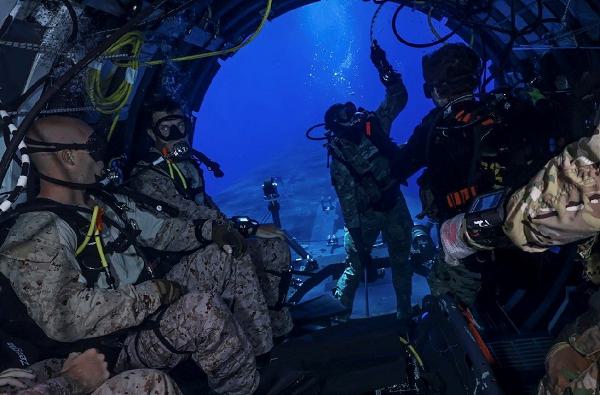
Mediterranean Sea. (August 17, 2024): Have you ever wondered how the U.S. Navy deploys and recovers special forces using submarines? In this photo by Petty Officer 2nd Class Almagissel Schuring, U.S. Marines from the 2nd Force Reconnaissance Company, assigned to Task Force 61/2, conduct dive training aboard the Ohio-class guided-missile submarine USS Georgia. The USS Ohio has a detachable Dry Deck Shelter that houses and deploys divers allowing easy exit and entrance while the boat is submerged.
Ever since Jules Verne’s fictional Nautilus, the Navy’s ability to deploy frogmen from submerged submarines has captured the public’s imagination. Frogmen in World War II conducted clandestine operations from the diesel-electric submarines of the period and today’s divers have a specially equipped “Lock Out trunk” that allows divers to remain dry as they transport to their launch site, don wetsuits and dive gear, and then exit and return to the sub undetected. The chamber, which can hold up to fourteen special operators, is filled with water until the pressure in and outside the ship equalizes allowing the hatch to open. Once outside, special forces access an operations box that contains their weapons and gear for the mission.
These Lock Out Trunks have multiple compartments for specific purposes. The forward-most compartment is a hyperbaric chamber used for treatment of injured divers. In the middle compartment, or transfer trunk, operators enter and exit the submarine and/or either of the other compartments. The third compartment is a hangar that houses either a SEAL Delivery submersible or a Combat Rubber Raiding Craft. To get back to the sub, Special Operators follow a pinging sonar that guides them back to the shelter once the mission is complete.
The Dry Deck Shelter can also be used to rescue the crew of a downed sub at depths up to six hundred feet. The hatch can release two crewmen at a time wearing survival suits through these special airlocks. With an expected forty-year service life, Dry Deck Shelters will likely continue to support the missions of Special Operations Forces for many years to come.
How Submarines Deploy Special Operators
- Details
- Hits: 3273


